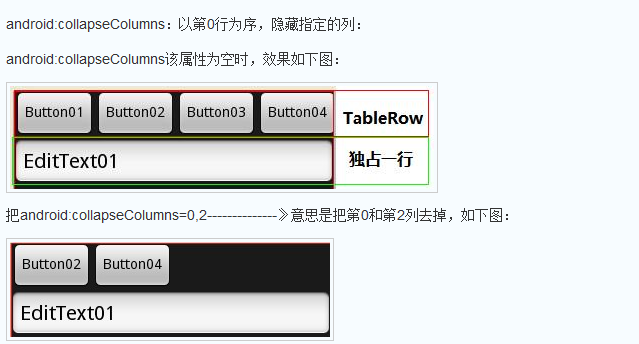TableLayout跟TableRow 是一组搭配应用的布局,TableLayout置底,TableRow在TableLayout的上方,而Button、TextView等控件就在TableRow之上,别的,TableLayout之上也可以零丁放控件。TableLayout是一个应用错杂的布局,最简单的用法就仅仅是拖沓控件做出个界面,但实际上,会经常在代码里应用TableLayout,例如做出表格的结果。本文首要介绍TableLayout的根蒂根基应用办法。
重要的几个属性如下:
1.android:collapseColumns://隐藏指定的列
①设置 TableLayout 内的 TableRow 中需要隐藏的列的列索引,多个用“,”隔开
②以第0行为序,隐藏指定的列:把android:collapseColumns=0,3 意思是把第0和第3列隐藏

2.android:shrinkColumns://收缩指定的列以适合屏幕、不会挤出屏幕 ① 设置 TableLayout 内的 TableRow 中需要拉伸(该列会拉伸到所有可用空间)的列的列索引,多列个用“,”隔开(多列 每列填充空隙大小一样)
②以第0行为序,自动延伸指定的列填充可用部分: 当LayoutRow里面的控件还没有布满布局时,shrinkColumns不起作用。
③设置了shrinkColumns=1,4,布局完全没有改变,因为LayoutRow里面还剩足够的空间。当LayoutRow布满控件时,设置了shrinkColumns=2,5,则控件自动向垂直方向填充空间

3.android:stretchColumns://尽量把指定的列表填充空白部分
①设置 TableLayout 内的 TableRow 中需要收缩(为了使其他列不会被挤到屏幕 外,此列会自动收缩)的列的列索引,多个用“,”隔开
② 以第0行为序,尽量把指定的列填充空白部分:设置stretchColumns=2,5,第1,4列被尽量填充同时向右填充,直到2,5被压挤到最后边)。

补充:
①表格布局的子对象不能指定 layout_width 属性.宽度永远是 MATCH_PARENT。
②不过子对象可以定义 layout_height 属性;其默认值是WRAP_CONTENT. 如果子对象是 TableRow,其高度永远是 WRAP_CONTENT。
实例:

001 |
<LinearLayout xmlns:android="http://schemas.android.com/apk/res/android" |
002 |
xmlns:tools="http://schemas.android.com/tools" |
003 |
android:layout_width="match_parent" |
004 |
android:layout_height="match_parent" |
005 |
android:orientation="vertical" |
006 |
tools:context=".AndroidTableLayoutActivity" > |
008 |
<!-- 定义第一个表格,指定第2列允许收缩,第3列允许拉伸 --> |
011 |
android:id="@+id/tablelayout01" |
012 |
android:layout_width="match_parent" |
013 |
android:layout_height="wrap_content" |
014 |
android:shrinkColumns="1" |
015 |
android:stretchColumns="2" > |
017 |
<!-- 直接添加按钮,自己占用一行 --> |
020 |
android:id="@+id/btn01" |
021 |
android:layout_width="wrap_content" |
022 |
android:layout_height="wrap_content" |
023 |
android:text="独自一行" > |
029 |
android:id="@+id/btn02" |
030 |
android:layout_width="wrap_content" |
031 |
android:layout_height="wrap_content" |
036 |
android:id="@+id/btn03" |
037 |
android:layout_width="wrap_content" |
038 |
android:layout_height="wrap_content" |
039 |
android:text="允许被收缩允许被收缩允许被收缩允许被收缩" > |
043 |
android:id="@+id/btn04" |
044 |
android:layout_width="wrap_content" |
045 |
android:layout_height="wrap_content" |
046 |
android:text="允许被拉伸允许被拉伸允许被拉伸" > |
050 |
<!-- 定义第2个表格,指定第2列隐藏 --> |
053 |
android:id="@+id/tablelayout02" |
054 |
android:layout_width="match_parent" |
055 |
android:layout_height="wrap_content" |
056 |
android:collapseColumns="1" > |
061 |
android:id="@+id/btn05" |
062 |
android:layout_width="wrap_content" |
063 |
android:layout_height="wrap_content" |
068 |
android:id="@+id/btn06" |
069 |
android:layout_width="wrap_content" |
070 |
android:layout_height="wrap_content" |
071 |
android:text="被隐藏列" > |
075 |
android:id="@+id/btn07" |
076 |
android:layout_width="wrap_content" |
077 |
android:layout_height="wrap_content" |
078 |
android:text="允许被拉伸" > |
082 |
<!-- 定义第3个表格,指定第2列填满空白 --> |
085 |
android:id="@+id/tablelayout03" |
086 |
android:layout_width="match_parent" |
087 |
android:layout_height="wrap_content" |
088 |
android:stretchColumns="1" > |
093 |
android:id="@+id/btn08" |
094 |
android:layout_width="wrap_content" |
095 |
android:layout_height="wrap_content" |
100 |
android:id="@+id/btn09" |
101 |
android:layout_width="wrap_content" |
102 |
android:layout_height="wrap_content" |
103 |
android:text="填满剩余空白" > |
107 |
<!-- 定义第3个表格,指定第2列横跨2列 --> |
110 |
android:id="@+id/tablelayout04" |
111 |
android:layout_width="match_parent" |
112 |
android:layout_height="wrap_content" > |
117 |
android:id="@+id/btn10" |
118 |
android:layout_width="wrap_content" |
119 |
android:layout_height="wrap_content" |
124 |
android:id="@+id/btn11" |
125 |
android:layout_width="wrap_content" |
126 |
android:layout_height="wrap_content" |
127 |
android:layout_column="2" |
128 |
android:text="填满剩余空白" > |
- Android ActionBar详解(三):ActionBar实现切换Tabs标签
实现切换Tabs标签; Activity代码: public class ActionBarTabs extends Activity { @Override protected void onCre ...
- Html5移动端页面自适应布局详解(阿里rem布局)
在移动设备上进行网页的重构或开发,首先得搞明白的就是移动设备上的viewport,通读网上的各种对于viewport的解释之后 大概viewport可以理解为三种 1.layout viewport ...
- (转)android Fragments详解三:实现Fragment的界面
为fragment添加用户界面 fragment一般作为activity的用户界面的一部分,把它自己的layout嵌入到activity的layout中. 一个 要为fragment提供layo ...
- 【转】Android编译系统详解(三)——编译流程详解
原文网址:http://www.cloudchou.com/android/post-276.html 本文原创作者:Cloud Chou. 欢迎转载,请注明出处和本文链接 1.概述 编译Androi ...
- Android Fragment详解(三): 实现Fragment的界面
为fragment添加用户界面: Fragment一般作为activity的用户界面的一部分,把它自己的layout嵌入到activity的layout中. 一个 要为fragment提供layout ...
- Android ActionBar详解(三)--->ActionBar的Home导航功能
FirstActivity如下: package cc.testsimpleactionbar2; import android.os.Bundle; import android.app.Activ ...
- Android Loader详解三:重启与回调
重启装载器 当你使用initLoader()时,如果指定ID的装载器已经存在,则它使用这个装载器.如果不存在呢,它将创建一个新的.但是有时你却是想丢弃旧的然后开始新的数据. 要想丢弃旧数据,你应使用r ...
- Android 布局详解
Android 布局详解 1.重用布局 当一个布局文件被多处使用时,最好<include>标签来重用布局. 例如:workspace_screen.xml的布局文件,在另一个布局文件中被重 ...
- Grid 网格布局详解
Grid网格布局详解: Grid布局与Flex布局有着一定的相似性,Grid布局是将容器划分成行和列,产生单元格,可以看做是二维布局. 基本概念: 采用网格布局的区域,称为"容器" ...
随机推荐
- Objective-C:协议protocol
六.协议(protocol) 关键字:@optional.@required (1)是一个类共享的一个方法列表 (2)它声明了一系列的方法而不进行实现 (3)遵从某个协议,就是需要实现协议中的方法 ( ...
- ButterKnife 注解 bindview
简介 官网:http://jakewharton.github.io/butterknife/ github:https://github.com/JakeWharton/butterknife 注意 ...
- Vue路由scrollBehavior滚动行为控制锚点
使用前端路由,当切换到新路由时,想要页面滚到顶部,或者是保持原先的滚动位置,就像重新加载页面那样. vue-router 能做到,而且更好,它让你可以自定义路由切换时页面如何滚动. 注意: 这个功能只 ...
- Java基础(一):简介
一.java基础语法: 一个Java程序可以认为是一系列对象的集合,而这些对象通过调用彼此的方法来协同工作.下面简要介绍下类.对象.方法和实例变量的概念. 对象:对象是类的一个实例,有状态和行为.例如 ...
- 转: Eclipse设置、调优、使用 (强烈推荐)
转注:写的非常详累,并且图文并茂,值得一看. http://yuanzhifei89.iteye.com/blog/974082 eclipse调优 一般在不对eclipse进行相关设置的时候,使用e ...
- (转)Unity中武器与人物的碰撞检测
自:http://blog.csdn.net/Monzart7an/article/details/24435843 目前来说有三种思路,其实前两种算变种了: 1.动画关键帧回调 + 范围检测. 这个 ...
- [Angular-Scaled web] 2. Architecture sub-modules
Common models will be a sub models for category and bookmarks. Because they are used everywhere. For ...
- 免费的HTML商业模板-Hidayah
在线演示 在线演示 本地下载 在这款模板中,你可以随意缩放大小,适合笔记本.平板电脑或手机,非常方便阅读.
- C# 64位系统调用32位DLL异常解决办法(异常来自HRESULT :0x8007007E)
解决办法如下 1.在IDE中将目标平台设置成x86(VS是在项目的属性->生成->目标平台) 2.如果DLL中调用了其他的DLL,需要将其他的DLL一同编译 3.有时DLL生成时会依赖于I ...
- error: Microsoft Visual C++ 9.0 is required. Get it from http://aka.ms/vcpython27
G:\Soft\python\word_cloud-master>python setup.py install error: Microsoft Visual C++ 9.0 is requi ...




